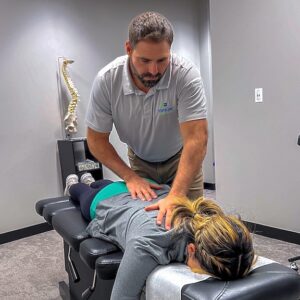In the hustle and bustle of modern life, many of us find ourselves spending prolonged hours at desks or engaged in repetitive tasks that can take a toll on our bodies. One common issue that arises from such activities is carpal tunnel syndrome, a condition characterized by pain, tingling, and numbness in the hand and arm. While traditional treatments exist, an increasing number of individuals are turning to chiropractic solutions for effective carpal tunnel relief. In this blog post, we will delve into the reasons behind this shift and explore the benefits of seeking chiropractic care, especially from a chiropractor near you.
Understanding Carpal Tunnel Syndrome:
Before exploring the chiropractic approach to carpal tunnel syndrome, it’s essential to delve deeper into the intricacies of this prevalent condition. The carpal tunnel, a slender passageway located in the wrist, serves as a conduit for various tendons and the median nerve. This nerve plays a pivotal role in controlling sensations and movements in the thumb and fingers. When heightened pressure builds up within the carpal tunnel, it leads to compression of the median nerve, giving rise to the distinctive symptoms associated with carpal tunnel syndrome.
The genesis of carpal tunnel syndrome is often rooted in the demands of modern-day activities. Repetitive motions, such as prolonged periods of typing or consistent use of handheld devices, contribute significantly to the development of this condition. The repetitive stress on the wrist and surrounding structures can lead to inflammation and swelling within the carpal tunnel, further exacerbating the compression of the median nerve. Additionally, poor ergonomics in workspaces and daily activities can act as compounding factors, intensifying the impact of repetitive stress. Understanding these intricate dynamics lays the groundwork for appreciating the holistic and targeted approaches that chiropractors employ in mitigating the symptoms and addressing the root causes of carpal tunnel syndrome.
The Chiropractic Approach:
Chiropractic care focuses on the relationship between the spine and the nervous system, aiming to optimize overall health. When it comes to carpal tunnel relief, chiropractors use a holistic approach that goes beyond merely addressing the symptoms. Here are some key reasons why choosing chiropractic solutions can be beneficial:
Holistic Assessment:
Chiropractors adopt a holistic healthcare perspective, recognizing the interconnectedness of the body’s systems. In addressing carpal tunnel syndrome, their assessment extends beyond the affected wrist, encompassing a thorough examination of the spine, posture, and various relevant factors. This comprehensive approach ensures that potential contributing factors are identified and addressed, promoting a more nuanced and effective treatment strategy.
Spinal Adjustments for Optimizing Nerve Flow:
Central to chiropractic philosophy is the understanding that the spine profoundly influences the nervous system. Through precise spinal adjustments, chiropractors aim to correct misalignments or subluxations that may impede optimal nerve flow. This targeted approach facilitates enhanced communication between the brain and affected areas, such as the hands and wrists impacted by carpal tunnel syndrome. By restoring proper alignment, chiropractic care seeks to alleviate the root cause of nerve compression.
Wrist and Joint Manipulation Techniques:
Employing hands-on techniques, chiropractors focus on manipulating the affected wrist and joints associated with carpal tunnel syndrome. This meticulous approach aims to relieve pressure, diminish inflammation, and improve joint mobility. By addressing the specific area of concern through manual manipulation, chiropractic care provides targeted and immediate relief, contributing to overall recovery.
Incorporating Soft Tissue Therapy:
Beyond spinal adjustments, chiropractors integrate soft tissue therapy into their treatment plans for carpal tunnel syndrome. Techniques such as massage, stretching, and trigger point therapy are utilized to address muscle tension and inflammation. This multifaceted approach enhances the overall effectiveness of chiropractic care, offering patients a well-rounded strategy for pain reduction and improved functionality.
Strategies for Posture Correction:
Recognizing the pivotal role of posture in musculoskeletal health, chiropractors work collaboratively with patients to identify and rectify postural issues contributing to carpal tunnel syndrome. This involves not only immediate interventions but also the implementation of ergonomic recommendations for workspaces, targeted exercises to strengthen supportive muscles, and lifestyle adjustments. By addressing posture comprehensively, chiropractors aim to mitigate the risk of recurrence.
Patient Education as Empowerment:
Education is a cornerstone of chiropractic care, with chiropractors aiming to empower patients through a deep understanding of their condition. This involves clear explanations of the underlying causes of carpal tunnel syndrome, the significance of spinal health, and proactive measures for prevention. By fostering informed decision-making, chiropractors encourage patients to actively participate in their recovery and take charge of their long-term well-being.
Tailored Treatment Plans for Individualized Care:
Acknowledging the uniqueness of each individual, chiropractors develop meticulously tailored treatment plans based on the specific needs and circumstances of the patient. Whether it entails a series of spinal adjustments, targeted joint manipulation, or a combination of therapeutic modalities, the treatment plan is customized to address the intricate factors contributing to carpal tunnel syndrome in each unique case.
Emphasis on Proactive Prevention:
Chiropractors go beyond providing immediate relief, placing a strong emphasis on proactive measures to reduce the risk of carpal tunnel syndrome recurrence. Ongoing adjustments, personalized exercises, and lifestyle recommendations form integral components of chiropractic care aimed at maintaining optimal spinal and musculoskeletal health. This preventive focus underscores chiropractic care as a holistic and enduring approach to overall wellness.
Collaboration within a Multidisciplinary Framework:
Chiropractors frequently collaborate with other healthcare professionals, recognizing the value of a multidisciplinary approach. In cases of carpal tunnel syndrome, collaboration may extend to working alongside orthopedic specialists, physical therapists, or occupational therapists. This collaborative effort ensures comprehensive care, addressing all facets of the condition and fostering a synergistic approach to the patient’s well-being.
Patient-Centered Approach for Enhanced Engagement:
Central to the chiropractic ethos is a patient-centered approach that places the individual at the forefront of their healing journey. Chiropractors actively engage in open communication with patients, encouraging them to express their concerns, preferences, and treatment goals. This collaborative and patient-focused approach not only fosters a sense of partnership but also contributes to a more effective and positive healthcare experience, aligning with the overarching philosophy of chiropractic care.
Finding a Chiropractor Near You:
Location Accessibility:
When seeking chiropractic care, the proximity of the chiropractor’s office is a critical consideration. Choosing a chiropractor near you ensures easy accessibility, minimizing travel time and making it more feasible to incorporate regular sessions into your schedule. This convenience can enhance the overall effectiveness of the treatment plan, as consistent attendance is often a key factor in achieving optimal results.
Local Reputation and Reviews:
Investigate the local reputation of chiropractors in your area by reading reviews and testimonials from other patients. Online platforms, such as Google Reviews or the chiropractor’s website, often provide valuable insights into the experiences of others. A chiropractor near you with positive reviews and a strong local reputation is more likely to provide quality care and a positive overall experience.
Referrals from Friends and Family:
Seek recommendations from friends, family, or colleagues who have personal experiences with chiropractors in your vicinity. Personal referrals can offer valuable insights into the chiropractor’s bedside manner, treatment effectiveness, and overall patient satisfaction. This firsthand information can guide you in making an informed decision about the chiropractor near you.
Insurance Coverage:
Verify whether the chiropractor accepts your health insurance plan. Understanding the extent of your insurance coverage for chiropractic services can significantly impact your decision-making process. A chiropractor near you who is in-network with your insurance provider may be more cost-effective and accessible.
Specialization and Expertise:
Assess the chiropractor’s specialization and expertise, especially in areas relevant to your specific needs. Some chiropractors focus on sports injuries, while others specialize in conditions like sciatica or carpal tunnel syndrome. Choosing a chiropractor near you with expertise in your particular area of concern ensures that you receive targeted and effective care.
Initial Consultation and Communication:
Schedule an initial consultation with the chiropractor to assess their communication style, willingness to listen, and ability to explain treatment plans. A chiropractor near you who values open communication and takes the time to understand your concerns is more likely to provide personalized and patient-centered care.
Techniques and Treatment Approaches:
Inquire about the chiropractor’s preferred techniques and treatment approaches. Some chiropractors may focus on manual adjustments, while others incorporate additional therapies such as massage, stretching, or rehabilitative exercises. Understanding the chiropractor’s approach ensures alignment with your preferences and comfort level.
Availability of Additional Services:
Consider whether the chiropractor near you offers additional services that complement chiropractic care, such as physiotherapy, nutritional counseling, or wellness programs. A comprehensive approach that addresses various aspects of health and well-being may contribute to a more holistic and integrated experience.
Chiropractic Care Beyond Carpal Tunnel:
While this blog has focused on carpal tunnel relief, it’s important to note that chiropractic care extends beyond addressing specific conditions. Regular chiropractic adjustments contribute to overall well-being by enhancing the body’s natural healing mechanisms and promoting optimal nervous system function. Many individuals find that chiropractic care positively impacts not only their immediate symptoms but also their general health and vitality.
Choosing chiropractic solutions for carpal tunnel relief offers a holistic and personalized approach to addressing the root causes of the condition. With spinal adjustments, joint manipulation, posture correction, and customized treatment plans, chiropractors aim to provide effective and lasting relief. If you’re seeking a chiropractor near you, consider Evolve Chiropractic in Huntley, Illinois, for comprehensive chiropractic services tailored to your individual needs. Embrace the benefits of chiropractic care and take a proactive step towards a healthier, pain-free life.
10705 Ruth Rd, Huntley, IL 60142, United States
847-802-4866
https://myevolvechiropractor.com/locations/chiropractor-in-huntley-illinois





